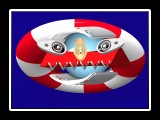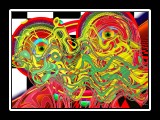Photography & Art for a visual hungry world






CLICK ANY IMAGE TO ENLARGE AND VIEW SLIDE SHOW


















Photography & Art for a visual hungry world






CLICK ANY IMAGE TO ENLARGE AND VIEW SLIDE SHOW


















New Media concerns are often derived from the telecommunications, mass media and digital modes of delivery the artworks involve, with practices ranging from conceptual to virtual art, performance to installation.
The origins of new media art can be traced to the moving photographic inventions of the late 19th century such as the zoetrope (1834), the praxinoscope (1877) and Eadweard Muybridge's zoopraxiscope (1879).
During the 1960s the development of then new technologies of video produced the new media art experiments of Nam June Paik, Wolf Vostell and A. Michael Noll, and multimedia performances of Fluxus. At the end of the 1980s the development of computer graphics, combined with real time technologies then in the 1990s with the spreading of the Web and the Internet favored the emerging of new and various forms of interactivity Lynn Hershman Leeson, David Rokeby, Don Ritter, Perry Hoberman, telematic art Roy Ascott, Internet Vuk Ćosić, Jodi, virtual and immersive art Jeffrey Shaw, Maurice Benayoun and large scale urban installation Rafael Lozano-Hemmer.
World Skin (1997), Maurice Benayoun's Virtual Reality Interactive InstallationSimultaneously
advances in biotechnology have also allowed artists like Eduardo Kac to begin
exploring DNA and genetics as a new art medium.
Contemporary New Media Art influences on new media art have been the theories developed around hypertext, databases, and networks. Important thinkers in this regard have been Vannevar Bush and Theodor Nelson with important contributions from the literary works of Jorge Luis Borges, Italo Calvino, Julio Cortázar, Lev Manovich, and Douglas Cooper. These elements have been especially revolutionary for the field of narrative and anti-narrative studies, leading explorations into areas such as non-linear and interactive narratives. A contemporary timeline of media art can be found here.
Themes
G.H. Hovagimyan "A Soapopera for iMacs"
Maurizio Bolognini's programmed machines (Computer sigillati series, 1992):
hundreds of computers have been producing endless flows of random images.[4]In
the book New Media Art, Mark Tribe and Reena Jana named several themes that
contemporary new media art addresses, including computer art, collaboration,
identity, appropriation, open sourcing, telepresence, surveillance, corporate
parody, as well as intervention and hacktivism.[5] In the book Postdigitale,[6]
Maurizio Bolognini suggested that new media artists have one common denominator,
which is a self-referential relationship with the new technologies, the result
of finding oneself inside an epoch-making transformation determined by technological
development. Nevertheless New Media Art does not appear as a set of homogeneous
practices, but as a complex field converging around three main elements: 1)
the art system, 2) scientific and industrial research, and 3) politico-cultural
media activism. There are significant differences between scientist-artists,
activist-artists and technological artists closer to the art system, who not
only do have different training and technocultures, but also different artistic
production. This should be taken into account in examining the several themes
addressed by New Media Art.
Non-linearity can be seen as an important topic to new media art by artists like Bill Viola who explores the term as an approach to looking at varying forms of digital projects. This is a key concept since people acquired the notion that they were conditioned to view everything in a linear and clear-cut fashion. Now, art is stepping out of that form and allowing for people to build their own experiences with the piece. People always ask, "What is the difference between non-linearity and randomness?" Non-linearity describes a project that has freedom with certain parameters, whereas randomness has freedom and no boundaries whatsoever. Non-linear art usually requires the participation of an audience to reveal its non-linearity while random art, more-or-less, acts on its own. When looking at Public Secrets, one can see this piece as non-linear due to ideas stressed by people like Viola. In doing so, viewers can understand another theme in the many forms of new media art. The participatory aspect of new media art, which for some artists has become integral, emerged from Allan Kaprow's 'Happenings'.
The inter-connectivity and interactivity of the internet, as well as the fight between corporate interests, governmental interests, and public interests that gave birth to the web today, fascinate and inspire a lot of current New Media Art.
Many new media art projects also work with themes like politics and social consciousness, allowing for social activism through the interactive nature of the media. Some examples include Sharon Daniel's Public Secrets, a site that shows oppression and struggles behind the prison system in America; Applied Autonomy's Terminal Air, a site that demonstrates the practices of United States Central Intelligence Agency's extraordinary rendition program; Beyondmedia Education, a non-profit organization that collaborates with under-served women, youth, and communities to create and distribute media arts on social justice topics including gender violence and school safety; and Michael Mandiberg's The Oil Standard, a Firefox plugin that shows all prices of online products in the cost of barrels of crude oil.
[edit] Presentation & PreservationAs the technologies used to deliver works of new media art such as film, tapes, web browsers, software and operating systems become obsolete, New Media art faces serious issues around the challenge to preserve artwork beyond the time of its contemporary production. Currently, research projects into New media art preservation are underway to improve the preservation and documentation of the fragile media arts heritage (see DOCAM - Documentation and Conservation of the Media Arts Heritage).
Methods of preservation exist, including the translation of a work from an obsolete medium into a related new medium, the digital archiving of media (see Internet Archive), and the use of emulators to preserve work dependent on obsolete software or operating system environments.
http://en.wikipedia.org/wiki/New_media_art